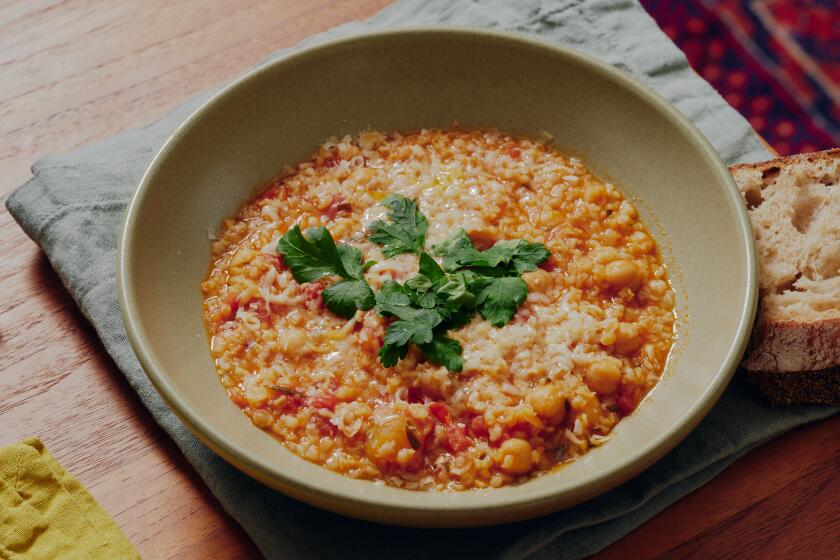Wizard's Barbecue (Shinsullo or Jungol)
The century has turned. The computer bug we feared didn’t affect much, and by now we’ve repaired any damages our holiday parties may have caused. It was fun, and it’s not over yet for me.
Being Korean American, I get to celebrate twice: first the solar new year on Jan. 1, and second the lunar new year, which changes annually with the cycle of the moon. This year, Saturday marks the start of the lunar year.
Lunar new year, or Sol in Korean, is the first day of the year and the first day of spring in Korea. It is a time to sweep away the misfortunes of the previous year and look forward to new endeavors. But the celebrations don’t stop there. The traditional folk festival, Jishin Balpgi, is celebrated on the first full moon of the new year.
Jishin Balpgi, which literally translates as “stepping on the spirit of the earth,” originates from a time when most Koreans lived in farming villages, according to the National Korean American Service and Education Consortium. It symbolized the collective ritual cleansing of the village and the chasing away of the bad spirits of the old year. The festival was a period of renewing personal ties and fostering a sense of community among the villagers.
During Jishin Balpgi, a group of musicians travels around the village playing the poongmul, or traditional Korean drums. They then visit individual homes to wish the residents peace and good fortune for the coming year through a combination of drumming, dancing and chanting.
In return, the hosts offer rice cakes and wine to the musicians and donate money to be used for the betterment of the entire village.
At night, people gather at the center of the village (madang) to celebrate under the first full moon of the new year. As the villagers eat, drink and play games together, they renew old friendships and reaffirm their bond as a community.
Traditional games against neighboring villages are another part of the Jishin Balpgi festival. These games can be as benign as a tug of war or as dramatic as stone fights and mock battles with torches. According to tradition, the winning village will be blessed with a bountiful harvest.
This custom may have originated from when neighboring villages shared a water source and had to determine priority for drawing water for fields.
Now, with more than a quarter of South Korea’s population living in Seoul and other cities, everyone tries to visit relatives in the country for the new year. Many city dwellers have extended families living in farming communities, and they go not only to view the festival but also to pay respect to their elders.
My father was one of those city dwellers who would pack his family off to some distant province in the dead of winter for the new year. Because my father was one of 16 children, I never knew exactly which uncle’s house we were going to visit.
I remember being forced out of bed in the darkness of the winter dawn, hastily dressing in the jolting cold to catch some crowded train out of the city.
The long trek to the countryside was always rewarded with plenty of snow to play in and plenty of cousins to play with. My siblings and I would run around, ruining our new traditional clothes (hanbok) falling and laughing in the dirty snow.
The best part of Sol for me was sneaking into the kitchen while the mothers were occupied and peering into the huge pot of ttokkuk boiling over the fire. I would climb onto something precarious and inhale the aroma of the steaming soup while salivating with anticipation until one of the women discovered me and chased me out of the kitchen.
Some people put mandu, Korean dumplings, into their ttokkuk, but our family is full of purists. We always have the soup with rice cakes, untainted by the nontraditional mandu. Each year when the women would serve up the hot bowls, either Uncle No. 3 or Uncle No. 5 (I forget which one) would inevitably say that we were “eating another year.”
But before we could sit down for breakfast, we had to take care of our familial obligations. First, we would pay respect to our ancestors with ceremonial bows. Then, we could eat.
After breakfast, the younger generation paid respect to our elders with a ceremonial bow, called saebae.
As the oldest members of the family sat cross-legged on the floor, the successive generations would take turns wishing them prosperity and good fortune. After all the bowing was over, the elders lectured the younger ones. Sometimes there was a pearl of wisdom offered, but more often than not it was a stern warning to do well in school.
Our rewards for being young and sitting patiently while the older folks droned on about this and that were the wads of cash, candy and fruit generously placed into our outstretched hands.
Later, the kids were free to play and the women were back in the kitchen, preparing for the next meal, several hours away.
This year, I’m far from the Korean village of our family. And this year, as years before, I will be the one chasing the children away from the kitchen. I will be the one handing out lucky money to my bowing nieces and nephews. And when I sit down to that bowl of ttokkuk, I will not only be another year fuller, but I hope another year wiser.
In large pot, boil brisket in water 2 to 3 hours until stock has reduced to 2/3. Set aside.
In shallow tabletop electric skillet, arrange 1/2 cabbage pieces, 1/2 onion slices, 1/2 zucchini semicircles, 1/2 tofu pieces, 1/2 carrot pieces, 1/2 green onion slices, 1/2 mushrooms, 1/2 rib eye, 1/2 egg quarters and 1/2 fish cake slices so they radiate out from center. Stack ingredients with more colorful pieces on top. Add more ingredients as space allows; set aside remaining ingredients.
Remove brisket from pot and reserve for another use. Pour broth slowly and carefully over arrangement in skillet. Simmer over low heat until rib eye is cooked thoroughly, about 20 minutes. Season with salt and pepper. Add remaining ingredients to skillet throughout course of meal to cook as needed.
Get our Cooking newsletter.
Your roundup of inspiring recipes and kitchen tricks.
You may occasionally receive promotional content from the Los Angeles Times.















